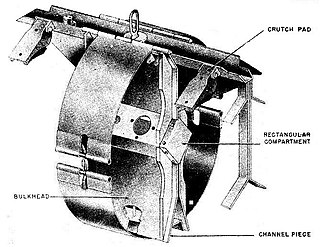
The Type 11 70 mm infantry mortar, was a muzzle-loading, rifled bore infantry mortar used by the Japanese. The Type 11 designation was given to this gun as it was accepted in the 11th year of Emperor Taishō's reign (1922). It was first used in 1922 and was the first mortar to be introduced by the Imperial Japanese Army. The mortar was later replaced by the Type 92 battalion gun.

The Type 4 20 cm rocket mortar was a 203 mm rocket mortar used by the Imperial Japanese Army in the final stages of World War II.

Ammunition is the material fired, scattered, dropped or detonated from any weapon or weapon system. Ammunition is both expendable weapons and the component parts of other weapons that create the effect on a target. Nearly all mechanical weapons require some form of ammunition to operate.
In military munitions, a fuze is the part of the device that initiates function. In some applications, such as torpedoes, a fuze may be identified by function as the exploder. The relative complexity of even the earliest fuze designs can be seen in cutaway diagrams.

The Henschel Hs 297 Föhn or 7.3 cm Raketen Sprenggranate was a small German surface-to-air rocket of the Second World War. The associated multiple rocket launcher was known as the 7.3 cm Föhn-Gerät.

The Type 99 81 mm mortar was a Japanese mortar used primary by Imperial Japanese Army during World War II. The Type 99 designation was given to this gun as it was accepted in the year 2599 of the Japanese calendar (1939). The Type 99 81 mm mortar is typical of the Stokes-Brandt type mortar. The Type 99 81 mm mortar differs from the Type 97 81 mm infantry mortar in the shortness of its tube and in the method of firing. The differences between the Type 99 and the US 81-mm mortar, M1 are pronounced.

The Type 10 and Type 3 rocket boosters were rocket artillery systems used by garrison troops of the Imperial Japanese Navy during the late stages of World War II in defense of island bases in the Pacific.

The 20 cm naval rocket launcher was a rocket artillery system used by the Imperial Japanese Navy in the final stages of World War II.

The AB 250-2(Abwurfbehälter) was a cluster bomb used by the Luftwaffe during World War II.

The BDC 10 was a cluster bomb used by the Luftwaffe during World War II.

The SB 2500 (Spezialbombe) was a luftmine or aerial mine in English used by the Luftwaffe during World War II.

The SD 50 or thick walled explosive bomb in English was a fragmentation bomb used by the Luftwaffe during World War II.

The SD 70 or thick walled explosive bomb in English was a fragmentation bomb used by the Luftwaffe during World War II.

The SD 250 or thick walled explosive bomb in English was a fragmentation bomb used by the Luftwaffe during World War II.

The SD 15 or thick walled explosive bomb in English was a fragmentation bomb used by the Luftwaffe during World War II.

The AB 500-3A(Abwurfbehälter) was a cluster bomb used by the Luftwaffe during World War II.

The AB 500-1B(Abwurfbehälter) was a cluster bomb used by the Luftwaffe during World War II.

The AB 500-1(Abwurfbehälter) was a cluster bomb used by the Luftwaffe during World War II.

The 45 cm naval rocket was a rocket artillery system used by garrison troops of the Imperial Japanese Navy during the late stages of World War II in defense of island bases in the Pacific.




















